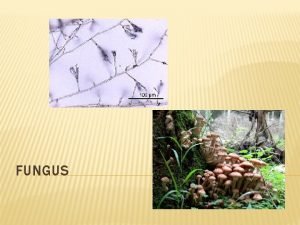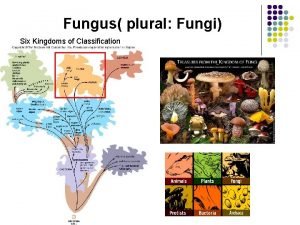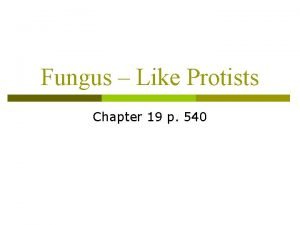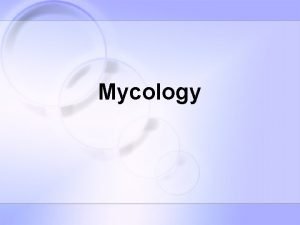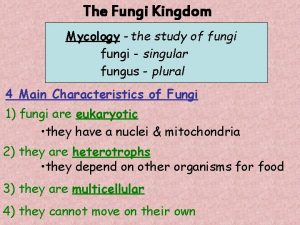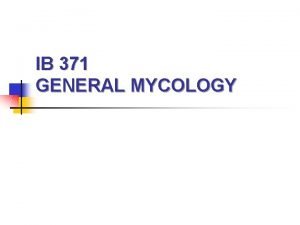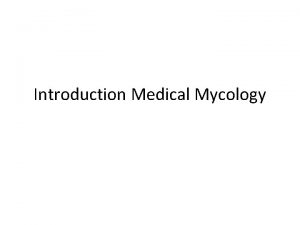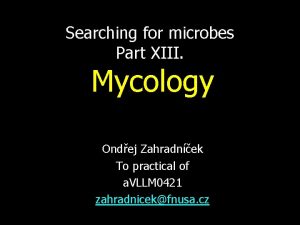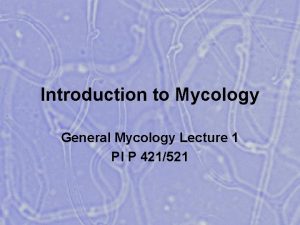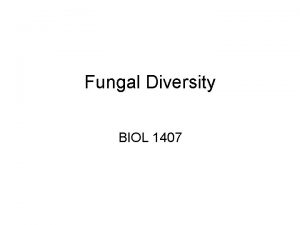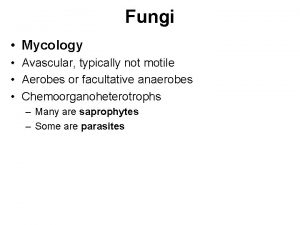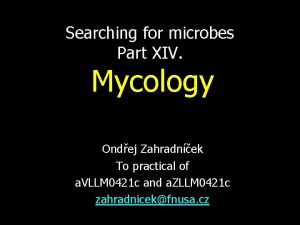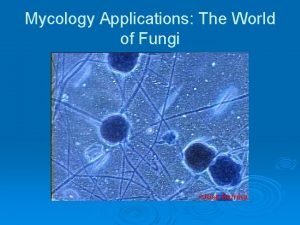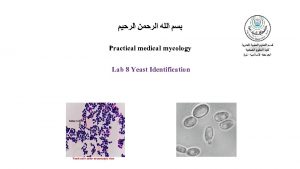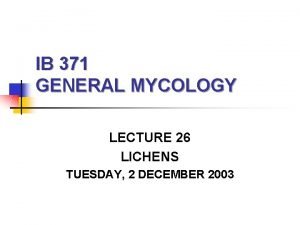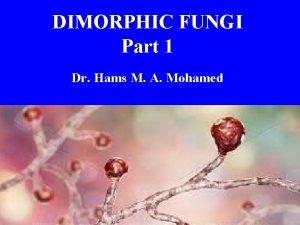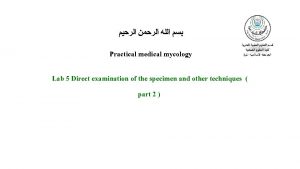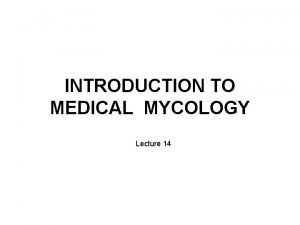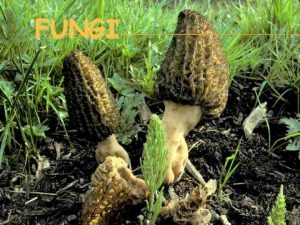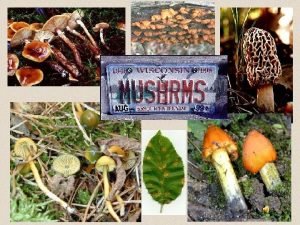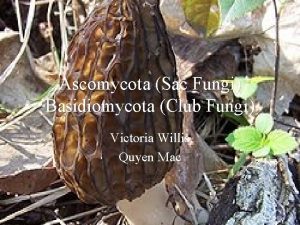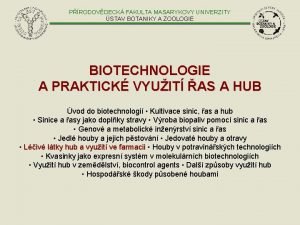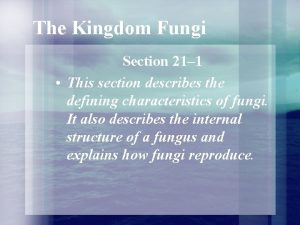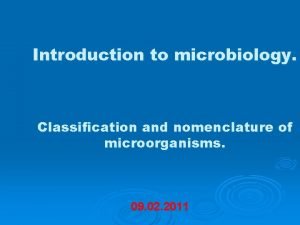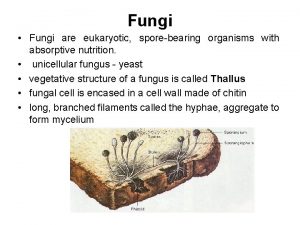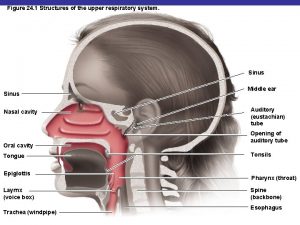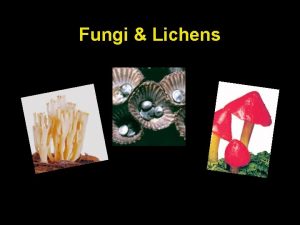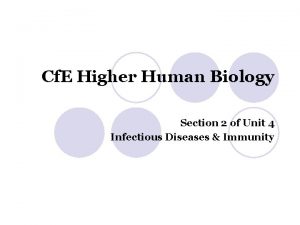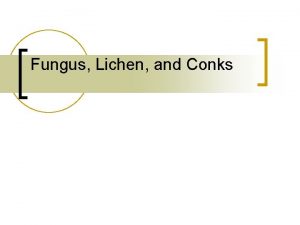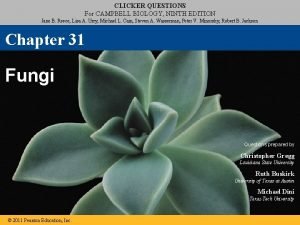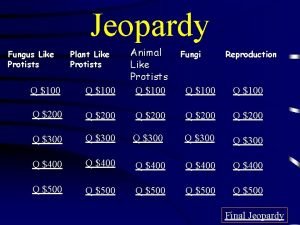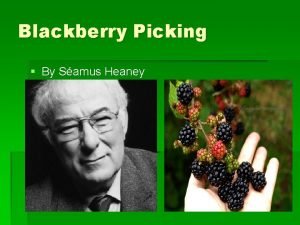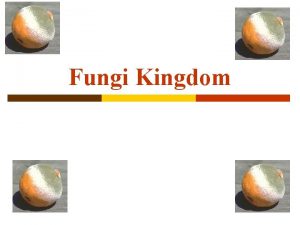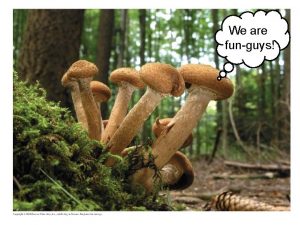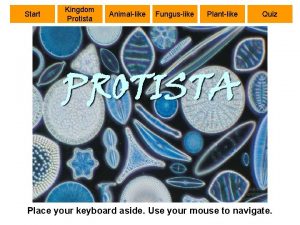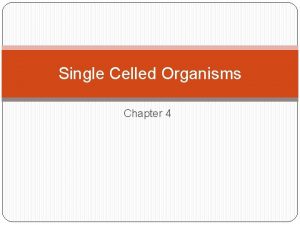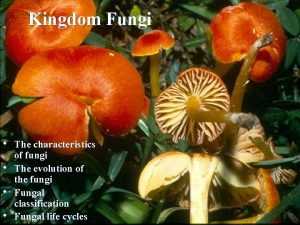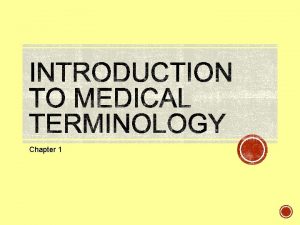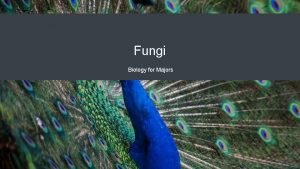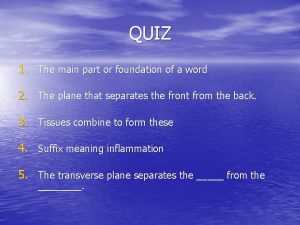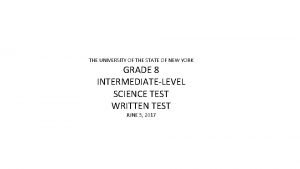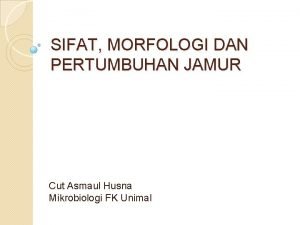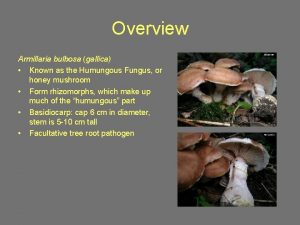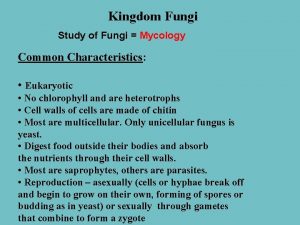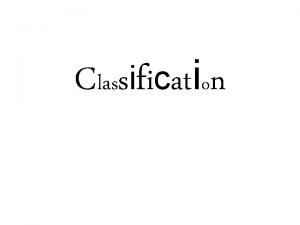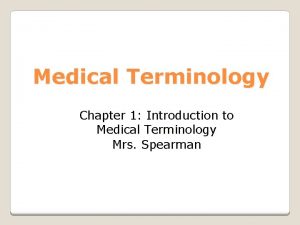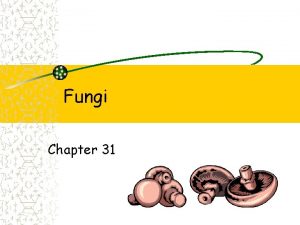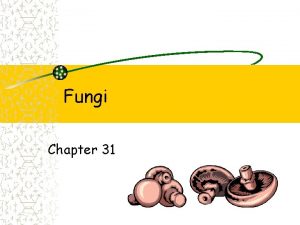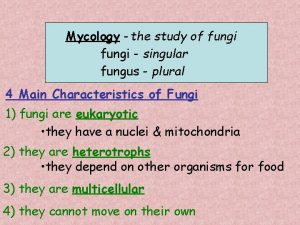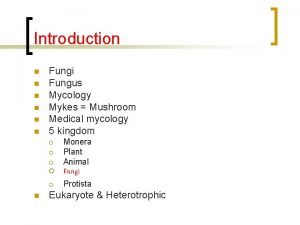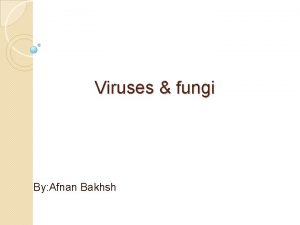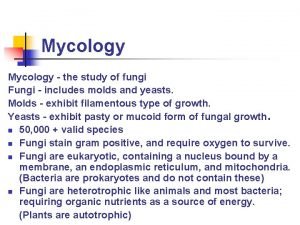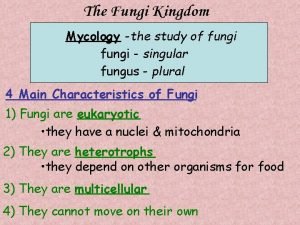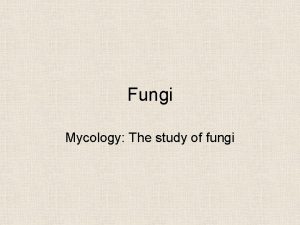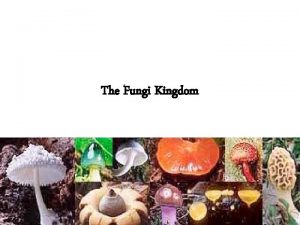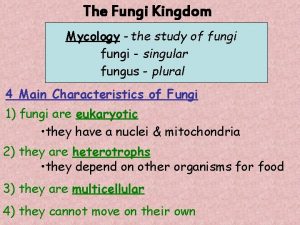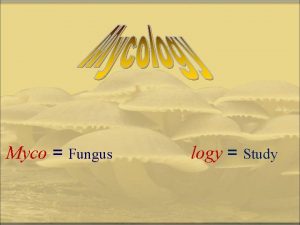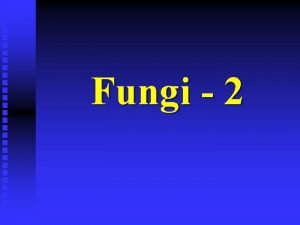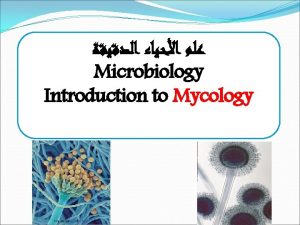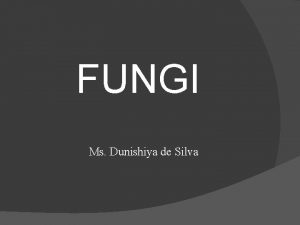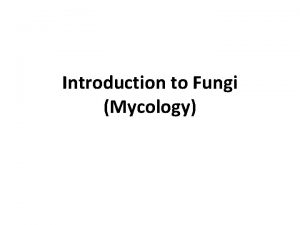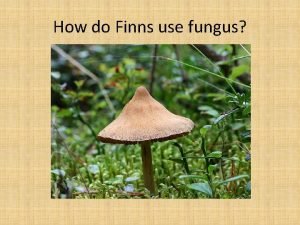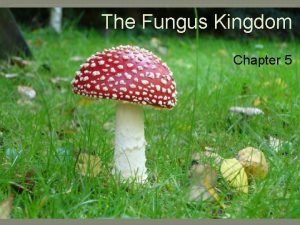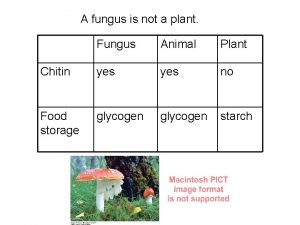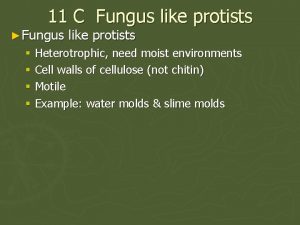FUNGI 1 FUNGI Mycology study of fungus 2























































- Slides: 55

FUNGI 1

FUNGI Mycology- study of fungus 2

Characteristics 3

THE CHARACTERISTICS OF FUNGI Fungi are NOT plants (they are eukaryotes) Non-photosynthetic (chemoheterotrophsrequire organic compounds for energy) 4

THE CHARACTERISTICS OF FUNGI Most are aerobic Non-motile Most are saprobes (live on dead organisms) Release digestive enzymes to break down organic material or their host BREAD MOLD 5

THE CHARACTERISTICS OF FUNGI Important decomposers & recyclers of nutrients in the environment Most are multicellular, except unicellular yeast Lack true roots, stems or leaves MULTICELLULAR MUSHROOM UNICELLULAR YEAST 6

THE CHARACTERISTICS OF FUNGI Some fungi are internal or external parasites A few fungi act like predators & capture prey like roundworms Predaceous Fungi feeding on a Nematode (roundworm) 7

THE CHARACTERISTICS OF FUNGI Some are edible, while others are poisonous EDIBLE POISONOUS 8

THE CHARACTERISTICS OF FUNGI Produce both sexual and asexual spores Classified by their sexual reproductive structures Spores come in various shapes 9

THE CHARACTERISTICS OF FUNGI Fungi include puffballs, yeasts, mushrooms, toadstools, rusts, smuts, ringworm, and molds The antibiotic penicillin is made by the Penicillium mold Puffball 10

Vegetative Structures NON-REPRODUCTIVE 11

STRUCTURES OF FUNGI Cell walls are made of chitin (complex polysaccharide) Body is called the Thallus Grow as microscopic tubes or filaments called hyphae 12

HYPHAE Tubular shape ONE continuous cell Filled with cytoplasm & nuclei Multinucleate Hard cell wall of chitin also in insect exoskeletons 13

HYPHAE Stolons – horizontal hyphae that connect groups of hyphae to each other Rhizoids – rootlike parts of hyphae that anchor the fungus STOLON RHIZOIDS 14

HYPHAE Cross-walls called SEPTA may form compartments Septa have pores for movement of cytoplasm Form network called mycelia that run through the thallus (body) 15

ABSORPTIVE HETEROTROPH Fungi get carbon from organic sources Tips of Hyphae release enzymes Enzymatic breakdown of substrate Products diffuse back into hyphae Nucleus “directs” the digestive process Digested material is then used by the hypha

MODIFICATIONS OF HYPHAE Fungi may be classified based on cell division (with or without cytokinesis) Aseptate or coenocytic (without septa) Septate (with septa) NO CROSS WALLS 17

MODIFICATIONS OF HYPHAE HAUSTORIA – parasitic hyphae on plants & animals Septate Hyphae Coenocytic Hyphae 18

HYPHAL GROWTH Hyphae grow from their tips Mycelium is an extensive, feeding web of hyphae Mycelia are the ecologically active bodies of fungi This wall is rigid Only the tip wall is plastic and stretches 19

REPRODUCTIVE STRUCTURES ASEXUAL & SEXUAL SPORES 20

REPRODUCTION Most fungi reproduce Asexually and Sexually by spores ASEXUAL reproduction is most common method & produces genetically identical organisms Fungi reproduce SEXUALLY when conditions are poor & nutrients scarce 21

SPORES Spores are an adaptation to life on land Ensure that the species will disperse to new locations Each spore contains a reproductive cell that forms a new organism Nonmotile Dispersed by wind 22

SEXUAL REPRODUCTION 23

SEXUAL REPRODUCTION Used when environmental conditions are poor (lack of nutrients, space, moisture…) No male or female fungi Some fungi show dimorphism May grow as MYCELIA or a YEAST –LIKE state (Filament at 25 o. C & Round at 37 o. C) Dimorphic Fungi 24

SEXUAL REPRODUCTION Haploid 1 n hyphae from 2 mating types (+ and -) FUSE (Fertilization) Forms a hyphae with 2 nuclei that becomes a ZYGOTE The zygote divides to make a SPORE + SPORE FORMS 25

ASEXUAL REPRODUCTION 26

THREE TYPES OF ASEXUAL REPRODUCTION Fragmentation – part of the mycelium becomes separated & begins a life of its own Budding – a small cell forms & gets pinched off as it grows to full size Used by yeasts Asexual spores – production of spores by a single mycelium 27

REPRODUCE BY SPORES Spores may be Formed: Directly on hyphae Inside sporangia On Fruiting bodies Penicillium hyphae Amanita fruiting body Pilobolus sporangia

ASEXUAL REPRODUCTION Fruiting Bodies are modified hyphae that make asexual spores An upright stalk called the Sporangiosphore supports the spore case or Sporangium 29

ASEXUAL REPRODUCTION Types of Fruiting Bodies: Basidia Sporangia Ascus Sporangia Basidia 30

Fruiting Bodies Both are composed of hyphae mycelium 31

HYPHAL GROWTH FROM SPORE Germinating spore Mycelia mycelium have a huge surface area More surface area aids digestion & absorption of food 32

IT’S ALL ABOUT THE SPORES! Fungi are classified by their REPRODUCTIVE STRUCTURES and SPORES The reproductive structures are: BASIDIA - BASIDIOMYCOTA SPORANGIA - ZYGOSPORANGIA ASCUS - ASCOMYCOTA 33

IT’S ALL ABOUT THE SPORES! Spores are made of: Dehydrated cytoplasm Protective coat Haploid cell Wind, animals, water, & insects spread spores Spores germinates when they land on a moist surface (new hyphae form) 34

Classification by Nutrition Saprobes Decomposers Molds, mushrooms, etc. Parasites Harm host Rusts and smuts (attack plants) Mutualists Both benefit Lichens Mycorrhizas 35

MAJOR GROUPS OF FUNGI Basidiomycota – Club Fungi Zygomycota – Bread Molds Chytridiomycota – Chytrids AM Fungi - Mycorrhizas Ascomycota – Sac Fungi Lichens – Symbiosis (algae & Fungi)

ZYGOMYCOTA 37

ZYGOMYCOTA Called the sporangium fungi Commonly called molds Also includes blights Hyphae have no cross walls (aseptate) Grow rapidly Includes bread mold Rhizopus stolonifer Rhizopus on strawberries Tomato Blight

ZYGOMYCOTA Asexual reproductive structure called sporangium atop sporangiospores make spores Rhizoids anchor the mold & release digestive enzymes & absorb food Stolons connect the fruiting bodies

ZYGOMYCOTA Sexual spores are produced by conjugation when (+) hyphae and (-) hyphae fuse Sexual spores are called ZYGOSPORES Zygospores can endure harsh environments until conditions improve zygospore

BASIDIOMYCOTA 41

BASIDIOMYCOTA Called Club fungi Includes: Mushrooms Toadstools Bracket & Shelf fungi Puffballs Stinkhorns Rusts and smuts

USES FOR BASIDIOMYCOTA Some are used as food (mushrooms) Others damage crops (rusts & smuts) Corn Smut Portobello Mushrooms Soybean Rust

CHARACTERISTICS OF CLUB FUNGI Seldom reproduce asexually The visible mushroom is a fruiting body Basidiocarp (fruiting body) is made of a stalk called the stipe and a flattened cap with gills called Basidia underneath Basidiospores are found on basidia Annulus is a skirt-like ring around some stipes Vegetative structures found below ground 44

Hyphal fusion mycelium and fruiting of haploid body are dikaryotic mycelia haploid mycelium MUSHROOM LIFE CYCLE N Meiosis 2 N N+N Nuclear fusion in basidium young basidia - the only diploid cells Fig 31. 12 45

ASCOMYCOTA 46

CHARACTERISTICS Called Sac fungi Includes Cup fungi, morels, truffles, yeasts, and mildew May be plant parasites (Dutch elm disease and Chestnut blight) Reproduce sexually & asexually Ascus - sac that makes ascospores in sexual reproduction Specialized hyphae known as Ascocarps contain the asci

CHARACTERISTICS Yeasts reproduce asexually by budding (buds break off to make more yeast cells) Asexual spores called conidia form on the tips of special hyphae called conidiophores CONIDIA

CONIDIA FORMATION 49

YEASTS BUDDING Saccharomyces

USES OF ASCOMYCETES Truffles and morels are good examples of edible ascomycetes Penicillium mold makes the antibiotic penicillin. Some ascomycetes also gives flavor to certain cheeses. Saccharomyces cerevesiae (yeast) is used to make bread rise and to ferment beer & wine.

CHYTRIDIOMYCOTA 52

CHYTRIDIOMYCOTA Called chytrids Produce motile spores Mostly saprobes and parasites in aquatic habitats Biodegrade and recycle nutrients Chytrid that attacks Potatoes

MYCORRHIZA 54

MYCORRHIZAS Fungus associated with plant roots Mutualism between: Fungus (nutrient & water uptake for plant) Plant (carbohydrate for fungus) Several kinds: Zygomycota – hyphae invade root cells Ascomycota & Basidiomycota – hyphae invade root but don’t penetrate cells Extremely important ecologically 55
 Mycology is the study of
Mycology is the study of Sexual or asexual reproduction
Sexual or asexual reproduction Fungus-like protists
Fungus-like protists Mycology test
Mycology test Mycology
Mycology Medical mycology ppt
Medical mycology ppt Mycology and lichens
Mycology and lichens Is yeast unicellular or multicellular
Is yeast unicellular or multicellular Metullae
Metullae Introduction of mycology
Introduction of mycology Glomerulomycota
Glomerulomycota Fungi motile
Fungi motile Mycology
Mycology Mycology
Mycology Industrial mycology
Industrial mycology Candida albicans germ tube test
Candida albicans germ tube test Mycology lecture
Mycology lecture Dimorphic fungi
Dimorphic fungi Tease mount preparation
Tease mount preparation Scotch tape preparation for fungi
Scotch tape preparation for fungi Haustorium in fungi
Haustorium in fungi Club fungi are morels truffles bracket fungi yeast
Club fungi are morels truffles bracket fungi yeast Club fungi definition
Club fungi definition Fungus chirurgorum
Fungus chirurgorum What is the main function of a fungus’s hyphae?
What is the main function of a fungus’s hyphae? Importance of microorganisms
Importance of microorganisms Conidiospores and sporangiospores
Conidiospores and sporangiospores Mycoplasma pneumoniae
Mycoplasma pneumoniae Club fungi characteristics
Club fungi characteristics Is giardia a fungus
Is giardia a fungus Fungus lichen and conks
Fungus lichen and conks General characteristics of fungi
General characteristics of fungi Clicker fungus
Clicker fungus White phlegm
White phlegm Acrasiomycota characteristics
Acrasiomycota characteristics Fungus jeopardy answer key
Fungus jeopardy answer key Blackberry picking analysis
Blackberry picking analysis Symbiotic organism
Symbiotic organism Dictyphora
Dictyphora Protist evolution
Protist evolution Single-celled prokaryotes
Single-celled prokaryotes What is fungi characteristics
What is fungi characteristics Mycosis a suffix denoting an abnormal condition of fungus
Mycosis a suffix denoting an abnormal condition of fungus Mucormycosis treatment
Mucormycosis treatment Fungus
Fungus Ponaris fungus
Ponaris fungus Draw flow chart of aseptate division of fungi
Draw flow chart of aseptate division of fungi Mycosis a suffix denoting an abnormal condition of fungus
Mycosis a suffix denoting an abnormal condition of fungus What do the rabbit, fungus, and tree have in common? *
What do the rabbit, fungus, and tree have in common? * Morfologi histoplasma capsulatum
Morfologi histoplasma capsulatum Humungous fungus band
Humungous fungus band What characteristics define a fungus
What characteristics define a fungus Fungi outline
Fungi outline Americanus species
Americanus species Saprophytic fungus
Saprophytic fungus The word root athr means ________.
The word root athr means ________.
